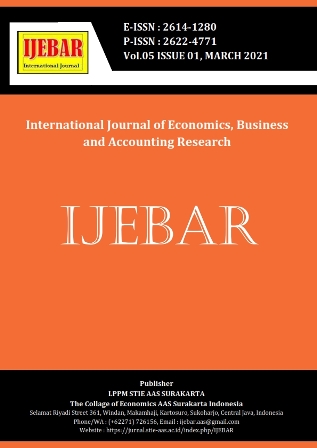FACTORS RELATED TO CHINESE CUSTOMERS’ ONLINE PURCHASE INTENTION: THE CASE STUDY OF JINGDONG.COM ONLINE SHOPPING’S CUSTOMER IN CHINA
DOI:
https://doi.org/10.29040/ijebar.v5i1.1721Abstract
References
Ahuja, M.J., Gupta, B., & Raman, P. (2003). An empirical investigation of online consumer purchasing behavior, Communication of the ACM. 46(12), 145 –151.
Ajzen, I. (1991). The theory of planned intention. Organizational intention and Human Decision Processes, 50(2), 179–211.
Anderson, R.E., Srinivasan, S.S., (2003). E-satisfaction and e-loyalty: A contingency framework. Psychology Marketing. 20(2), 123–138.
Bhatnagar, A., Misra, S., & Rao, R. (2000). On Risk, Convenience and Internet Shopping Behavior. Communications of the ACM, 43(11), 98-105.
Biswas, D., & Biswas, A. (2004). The diagnostic role of signals in the context of perceived risks in online shopping: Do signals matter more on the web? Journal of Interactive Marketing, 18(3), 30-45.
Budiyono, M. T. I., Muliasari, D., & Putri, S. A. R. (2021). An Analysis of Customer Satisfaction Levels in Islamic Banks Based on Marketing Mix as a Measurement Tool. Annals of the Romanian Society for Cell Biology, 2004-2012.
Budiyono, Serly Andini Restu Putri. (2021). The Influence of Total Taxpayer of Personnel and Per Capita Income on Income Tax in Indonesia 2017 - 2019. Annals of the Romanian Society for Cell Biology, 1997–2003.
Charoensukmongkol, P. & Sasatanun, P. (2017). Social Media Use for CRM and Business Performance Satisfaction: The Moderating Roles of Social Skills and Social Media Sales Intensity, Asian Pacific Management Review, 22(1), 25-34.
Cheung, C. M. K., Chan, G. W. W., & Limayem, M. (2005). A critical review of online consumer behavior: Empirical research. Journal of Electronic Commerce in Organizations, 3(4), 1-19.
Gommans, M., Krishnan, K.S., Scheffold, K.B., (2001). From brand loyalty to e-loyalty: a conceptual framework. Journal of economic and Social Research. 3(1), 43–58.
Heng, M.S.H. (2003). Understanding electronic commerce from a historical Perspective. Communication of the Association for Information system, 12, 104-118.
La Ferle, C., Edwards, S.M. & Mizuno, Y. (2002). Internet Diffusion in Japan: Cultural Considerations. 42(2), 65–79.
Lewis, D & Bridger, D. (2003).The soul of the new consumer. London: Nicholas Brealey Publishing.
Lin, C.C., (2003). A critical appraisal of customer satisfaction and e-commerce. Managerial Auditing Journal, 18(3), 202–212.
Reichheld, F.F., Schefter, P., (2000). E-Loyalty: Your Secret Weapon on the Web. Harvard Business Review. 78, 105–113.
Sasatanun, P., & Charoensukmongkol, P. (2016). Antecedents and Outcomes Associated with Social Media Use in Customer Relationship Management of Microenterprises, International Journal of Technoentrepreneurship, 3(2), 127-149.
Sinha, J., & Kim, J.Y. (2012). Factors affecting online shopping intention of Indian consumers, Innovative Marketing, 8(2), 46-57.
Tarsakoo, P., & Charoensukmongkol, P. (2019). Dimensions of Social Media Marketing Capabilities and Their Contribution to Business Performance of Firms in Thailand, Journal of Asia Business Studies, 14(4), 441-461. https://doi.org/10.1108/JABS-07-2018-0204
Wijoseno, J. & Ariyanti, M. (2017), Perceived Factors Influencing Consumer Trust and Its Impact on Online Purchase Intention in Indonesia, International Journal of Science and Research, 6(8), 961-968.





 JMTOTO
JMTOTO